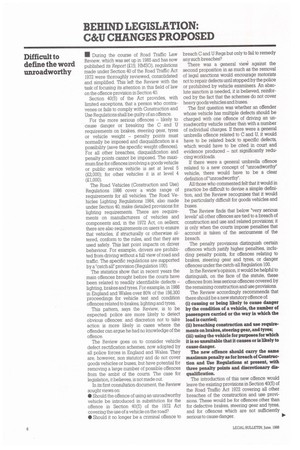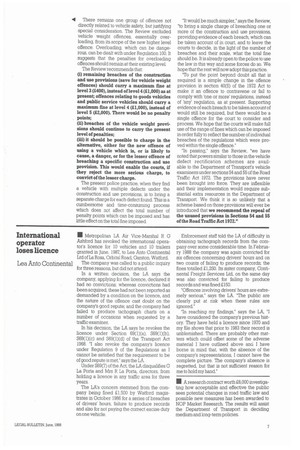Difficult to define the word =roadworthy
Page 72

Page 73

If you've noticed an error in this article please click here to report it so we can fix it.
• During the course of Road Traffic Law Review, which was set up in 1985 and has now published its Report (£15; HMSO), regulations made under Section 40 of the Road Traffic Act 1972 were thoroughly reviewed, consolidated and simplified. This left the Review with the task of focusing its attention in this field of law on the offence provision in Section 40,
Section 40(5) of the Act provides, with limited exceptions, that a person who contravenes or fails to comply with Construction and Use Regulations shall be guilty of an offence.
For the more serious offences likely to cause danger or breaking the C and U requirements on brakes, steering gear, tyres or vehicle weight penalty points must normally be imposed and disqualification is a possibility (save the specific weight offences). For all other breaches, disqualification and penalty points cannot be imposed. The maximum fine for offences involving a goods vehicle or public service vehicle is set at level 5 (£2,000); for other vehicles it is at level 4 (£1,000).
The Road Vehicles (Construction and Use) Regulations 1986 cover a wide range of requirements for all vehicles. The Road Vehicles Lighting Regulations 1984, also made under Section 40, make detailed provisions for lighting requirements. There are requirements on manufacturers of vehicles and components and, in the 1972 Act, on sellers; there are also requirements on users to ensure that vehicles, if structurally or otherwise altered, conform to the rules, and that they are used safely. This last point impacts on driver behaviour. For example, drivers are prohibited from driving without a full view of road and traffic. The specific regulations are supported by a "catchall" provision (Regulation 100).
The statistics show that in recent years the main offences brought before the courts have been related to readily identifiable defects lighting, brakes and tyres. For example, in 1986 in England and Wales over 80% of the 156,300 proceedings for vehicle test and condition offences related to brakes, lighting and tyres.
This pattern, says the Review, is to be expected: police are more likely to detect obvious offences: and discretion not to take action is more likely in cases where the offender can argue he had no knowledge of the offence.
The Review goes on to consider vehicle defect rectification schemes, now adopted by all police forces in England and Wales. They are, however, non statutory and do not cover goods vehicles or buses, but have potential for removing a large number of possible offences from the ambit of the courts. The case for legislation, it believes, is not made out.
In its first consultation document, the Review sought views on: • Should the offence of using an unroadworthy vehicle be introduced in substitution for the offence in Section 40(5) of the 1972 Act covering the use of a vehicle on the road?
• Should it no longer be a criminal offence to breach C and U Regs but only to fail to remedy any such breaches?
There was a general view against the second proposition in as much as the removal of legal sanctions would encourage motorists not to repair defects until stopped by the police or prohibited by vehicle examiners. An absolute sanction is needed, it is believed, reinforced by the fact that the schemes do not cover heavy goods vehicles and buses.
The first question was whether an offender whose vehicle has multiple defects should be charged with one offence of driving an unroadworthy vehicle rather than with a number of individual charges. If there were a general umbrella offence related to C and U, it would have to be related back to specific defects, which would have to be cited in court and evidence produced not significantly reducing workloads.
If there were a general umbrella offence related to a new concept of "unroadworthy" vehicle, there would have to be a clear definition of "unroadworthy".
All those who commented felt that it would in practice be difficult to devise a simple definition, and the Review recognises that it would be particularly difficult for goods vehicles and buses.
The Review finds that below "very serious levels" all other offences are tied to a breach of construction and use and related provisions; it is only when the courts impose penalties that account is taken of the seriousness of the breach.
The penalty provisions dictinguish certain offences which justify higher penalties, including penalty points, for offences relating to brakes, steering gear and tyres, or danger offences under the catch-all Regulation 100, In the Review's opinion, it would be helpful to distinguish, on the face of the statute, these offences from less serious offences covered by the remaining construction and use provisions.
The Review accordingly recommends that there should be a new statutory offence of: (i) causing or being likely to cause danger by the condition of a vehicle, the number of passengers carried or the way in which the load is carried; (ii) breaching construction and use requirements on brakes, steering gear, and tyres; (iii) using the vehicle for purposes for which it is so unsuitable that it causes or is likely to cause danger.
The new offence should carry the same maximum penalty as for breach of Construction and Use Regulations at present, with tluee penalty points and discretionary disqualification.
The introduction of this new offence would leave the existing provisions in Section 40(5) of the Road Traffic Act 1972 covering all other breaches of the construction and use provisions. These would be for offences other than for defective brakes, steering gear and tyres, and for offences which are not sufficiently serious to cause danger. • There remains one group of offences not directly related to vehicle safety, but justifying special consideration. The Review excluded vehicle weight offences, essentially overloading, from its scope of the new higher level offence. Overloading, which can be dangerous, can be dealt with under Regulation 100. It suggests that the penalties for overloading offences should remain at their existing level.
The Review recommends that (i) remaining breaches of the construction and use provisions (save for vehicle weight offences) should carry a maximum fine at level 3 (MOO), instead of level 4 (£1,000) as at present; offences relating to goods vehicles and public service vehicles should carry a maximum fine at level 4 (£1,000), instead of level 5 (12,000). There would be no penalty points; (ii) breaches of the vehicle weight provisions should continue to carry the present level of penalties; (iii) it should be possible to charge in the alternative, either for the new offence of using a vehicle which is, or is likely to cause, a danger, or for the lesser offence of breaching a specific construction and use provision. This would enable the courts, if they reject the more serious charge, to convict of the lesser charge.
The present police practice, when they find a vehicle with multiple defects under the construction and use provisions, is to bring a separate charge for each defect found. This is a cumbersome and time-consuming process which does not affect the total number of penalty points which can be imposed and has little effect on the total fine imposed. "It would be much simpler," says the Review, 'to bring a single charge of breaching one or more of the construction and use provisions, providing evidence of each breach, which can be taken account of in court, and to leave the courts to decide, in the light of the number of breaches and their scale, what the total fine should be. It is already open to the police to use the law in this way and some forces do so. We hope that the rest will now adopt this practice.
"To put the point beyond doubt all that is required is a simple change in the offence provision in section 40(5) of the 1972 Act to make it an offence to contravene or fail to comply with 'one or more' regulations, instead of 'any' regulation, as at present Supporting evidence of each breach to be taken account of would still be required, but there would be a single offence for the court to consider and process, We hope that the courts will make full use of the range of fines which can be imposed in order fully to reflect the number of individual breaches of the regulations which were proved within the single offence."
"In passing," says the Review, "we have noted that powers similar to those in the vehicle defect rectification schemes are available to the Department of Transport's vehicle examiners under sections 54 and 55 of the Road Traffic Act 1972. The provisions have never been brought into force. They are inflexible and their implementation would require substantial extra resources in the Department of Transport. We think it is so unlikely that a scheme based on those provisions will ever be introduced that we recommend the repeal of the unused provisions in Sections 54 and 55 of the Road Traffic Act 1972".
















































































































